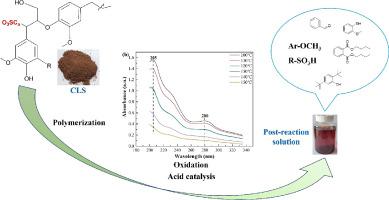当前位置:
X-MOL 学术
›
Hydrometallurgy
›
论文详情
Our official English website, www.x-mol.net, welcomes your feedback! (Note: you will need to create a separate account there.)
Behavior of calcium lignosulfonate under oxygen pressure acid leaching condition
Hydrometallurgy ( IF 4.8 ) Pub Date : 2024-04-21 , DOI: 10.1016/j.hydromet.2024.106317 Sijie Yang , Yuhu Li , Yudong Yang , Ran Liu , Yi Zhao
Hydrometallurgy ( IF 4.8 ) Pub Date : 2024-04-21 , DOI: 10.1016/j.hydromet.2024.106317 Sijie Yang , Yuhu Li , Yudong Yang , Ran Liu , Yi Zhao

|
The behavior of calcium lignosulfonate (CLS) in the oxygen pressure acid leaching process of ZnS concentrate was investigated using total organic carbon assessment (TOC), UV–visible spectrophotometry, Fourier transform infrared spectroscopy (FTIR), and gas chromatography-coupled mass spectrometry (GC–MS) as characterization methods. The effect of the CLS degradation products on zinc electrowinning was also discussed. The results showed that the temperature was positively correlated with the degradation of CLS, while the initial acidity had only significant effects in the range of 0–50 g/L and oxygen partial pressure range of 0–0.1 MPa. At an oxygen partial pressure of 0.2 MPa, an acidity of 160 g/L, and a reaction temperature of 150 °C, about 82.4% of CLS was degraded. In the oxygen pressure acid leaching process, CLS underwent polymerization and decomposition reactions, and its aromatic rings and side chain groups were damaged to varying degrees. At 120 °C, CLS was partially converted into sulfonic acids, phenols, and esters of higher molecular weights. At 150 °C, CLS further degraded into lower-molecular-weight aromatic ethers and sulfonic acids with shorter carbon chains. These organics were relatively stable and were the main sources of organic compounds during the oxygen pressure leaching process of zinc concentrates. The addition of CLS had a significant negative impact on zinc electrowinning, which was related to the adsorption of CLS on the cathode surface, enhancing cathodic polarization and inhibiting zinc reduction kinetics.
中文翻译:

木质素磺酸钙在氧压酸浸条件下的行为
采用总有机碳评估 (TOC)、紫外可见分光光度法、傅里叶变换红外光谱 (FTIR) 和气相色谱-质谱联用技术研究了木质素磺酸钙 (CLS) 在 ZnS 精矿氧压酸浸过程中的行为。 GC-MS)作为表征方法。还讨论了 CLS 降解产物对锌电解提取的影响。结果表明,温度与CLS的降解呈正相关,而初始酸度仅在0-50 g/L范围和氧分压0-0.1 MPa范围内有显着影响。在氧分压0.2MPa、酸度160g/L、反应温度150℃下,约82.4%的CLS被降解。在氧压酸浸过程中,CLS发生聚合和分解反应,其芳环和侧链基团受到不同程度的破坏。在 120°C 时,CLS 部分转化为磺酸、酚和较高分子量的酯。在 150 °C 时,CLS 进一步降解为较低分子量的芳香醚和碳链较短的磺酸。这些有机物相对稳定,是锌精矿氧压浸出过程中有机物的主要来源。 CLS的添加对锌电积有显着的负面影响,这与CLS在阴极表面的吸附,增强阴极极化,抑制锌还原动力学有关。
更新日期:2024-04-21
中文翻译:

木质素磺酸钙在氧压酸浸条件下的行为
采用总有机碳评估 (TOC)、紫外可见分光光度法、傅里叶变换红外光谱 (FTIR) 和气相色谱-质谱联用技术研究了木质素磺酸钙 (CLS) 在 ZnS 精矿氧压酸浸过程中的行为。 GC-MS)作为表征方法。还讨论了 CLS 降解产物对锌电解提取的影响。结果表明,温度与CLS的降解呈正相关,而初始酸度仅在0-50 g/L范围和氧分压0-0.1 MPa范围内有显着影响。在氧分压0.2MPa、酸度160g/L、反应温度150℃下,约82.4%的CLS被降解。在氧压酸浸过程中,CLS发生聚合和分解反应,其芳环和侧链基团受到不同程度的破坏。在 120°C 时,CLS 部分转化为磺酸、酚和较高分子量的酯。在 150 °C 时,CLS 进一步降解为较低分子量的芳香醚和碳链较短的磺酸。这些有机物相对稳定,是锌精矿氧压浸出过程中有机物的主要来源。 CLS的添加对锌电积有显着的负面影响,这与CLS在阴极表面的吸附,增强阴极极化,抑制锌还原动力学有关。
















































 京公网安备 11010802027423号
京公网安备 11010802027423号